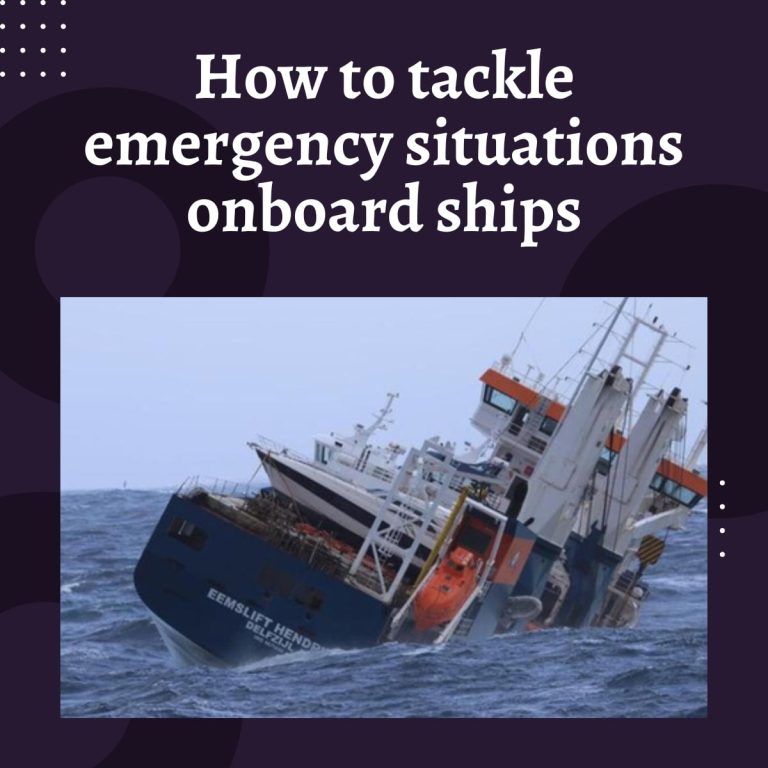
How to Tackle Emergency Situations On Board Ships
The capacity of the crew to respond to emergency events and prepare emergency equipment such as emergency power sources and fire pumps on ships are crucial elements in saving human lives, safeguarding the maritime environment, and reducing ship damage. Continuous training and practical drills onboard are essential in this respect, but they cannot guarantee that the crew will follow orders in the event of an emergency. So, here we share an informative guide on how to tackle emergency situations on board ships.
Despite proper preparation, many people experience panic attacks and are unable to act as they should in an emergency. A ship’s emergency scenario must be handled with confidence and composure since rash judgments and “jumping to conclusions” might exacerbate the crisis.
Table of Contents
Continuous training and practical exercises onboard ships may help crew members deal effectively with emergency circumstances. Nevertheless, it has been shown that, despite thorough preparation, people have panic episodes and, as a result, fail to respond appropriately in an emergency scenario.
In regards to the seafarer, he or she must first and foremost be informed of the many sorts of emergency scenarios that might occur onboard a ship. This would aid in a better understanding of the true situation, as well as the implementation of remedial steps to preserve lives, property, and the environment.
Thus, we have created a guide for seafarers that’ll help them to tackle emergency situations on Board Ships.
Emergency Essentials – Types of Emergency Situations On Board Ships
All staff must be informed of the location of firefighting equipment and lifesaving appliances, as well as be educated in their use, in order to make good use of the limited emergency equipment available on board.
In the event of an emergency, they must also be aware of the alarm signals, recognize them, and gather at the muster site.
The general alarm will be sounded in the event of:
- Fire
- Collision
- Grounding
- Cargo hose burst
- Major leakage or spillage of oil cargo
- Any other event that calls for emergency action
Other alarms could include:
- Engineer alarm for unmanned machinery spaces
- Carbon dioxide alarm
- Fire detector alarms
- Cargo tank level alarms
- Refrigerated store alarm
The fact that your ship’s alarms are blaring does not necessarily indicate that the issue is out of hand. Alarms are alerts that are heard to encourage those on board to take emergency precautions like as donning life jackets or congregating at a common location, depending on the sort of emergency and instructions provided to them.
Also Read: Lithium-Ion Batteries causing fire on ships? – Höegh Xiamen Case Study
Structure and Function of Emergency Response Teams
The basic structure of any emergency team will usually comprise four sub-groups.
- The Command Center
- The Emergency Team
- The Back-Up Squad
- The Technical Team
These sub-groups will do different duties while coordinating with one another.
Functions of Emergency Team Groups
- The Command Center
On the bridge, the command center will be positioned. The master will be responsible for the ship’s overall safety and navigation. All communications with the various teams as well as shore will be handled from here. All occurrences must be recorded in a log.
- The Emergency Team
The Emergency Team will be on the front lines in dealing with the crisis. In general, the chief officer will lead the team in an emergency on deck, while the 2nd engineer will handle problems in the engine room. To minimize duplication, misunderstanding, and anarchy, each person’s responsibilities must be written down and exercised in advance of any emergency.
- The Support Team
The Support Team is responsible for providing first assistance and lowering the lifeboats. They should help as requested if the aforementioned two functions are not necessary.
- The Technical Team
The ship’s propulsion and maneuvering capacity, as well as auxiliary services, will be maintained by the Technical, or Engineer’s, Team to the extent practicable under the conditions.
Guide To Tackle Emergency Situations On Board Ships
The ship’s Fire Training Manual and the training manual on Life Saving Appliances should be extensively studied by officers and crew to tackle emergency situations on board ships.
- In case of a general alarm, bring a life jacket and an immersion suit to the muster station, then follow the vessel’s Muster Lists.
- In case of a fire alarm, first check if the alarm is false or if there’s actually a fire onboard. Inform the officer on watch, try to stop the fire, and if it is not possible, muster according to the Fire Muster List.
- When there’s a man overboard signal, rush to the deck and try to locate the crew member fallen in the water, throw a lifebuoy and inform the deck.
- In case of an abandon ship signal, rush to the muster station, carry as much ration, water, and warm clothing as you can carry, and act according to the vessel’s Muster Lists.
- In case of engineers call, all engineers should assemble in the engine control room.
- If there’s a CO2 alarm, leave the engine room immediately.
- If the engine room floods, the Chief Engineer should be notified right away, and a general alert should be issued. In agreement with the Chief Engineer, immediate action should be made to prevent further seawater from entering the engine room. And, emergency bilging from the engine room should be established.
- In case of cargo hold flooding, the Master must be informed immediately. All precautions must be taken to contain the flooding to that hold and the general alarm must be raised.
- In the event of an oil leak or pollution, the vessel’s “Shipboard Oil Pollution Prevention Plan” should be followed immediately. In the event of an oil spill, the SOPEP and Onboard SOPEP Equipment placed in Deck Stores should be employed.
General Guidelines for Emergency Situations On Board Ships
All members of the technical crew must be well-versed in all of the ship’s emergency codes. In line with their duty during an emergency, all members of the crew should undergo adequate training.
Passengers on board must be informed of any potential threats, otherwise, the general public will get panicked. Understanding the effects of wind, current, shallow water, banks, and tight channels on the ship’s behavior is also critical. So that the technical team can react appropriately in emergency Situations on board Ships.
It is critical to close all watertight doors, fire doors, valves, scuppers, side-scuttles, skylights, portholes, and other similar openings on the ship to prevent ocean water from entering. If the ship is abandoned, all passengers must be saved first using life jackets and lifeboats, or they must be transferred to another ship.
Staff personnel should be the last to depart the ship, even if just to ensure that no one is left aboard the abandoned vessel. Modern ships are outfitted with high-tech and advanced life-saving equipment. And may easily contact off-shore rescue crews via mobile communication devices.
Conclusion
In conclusion, call for assistance in any other emergency situations on board ships, either via phone or by triggering the EMERGENCY CALL. Whatever the issue may be, keep the Master, Chief Engineer, and Officer on Watch informed at all times. So, we hope you got the knowledge about to tackle emergency situations on board ships.
Also read: 13 Important Organizations Seafarers Can Contact For Help: A Global Guide
Click here to join our Telegram chanel
You will get information, news, and support related to Merchant Navy.


